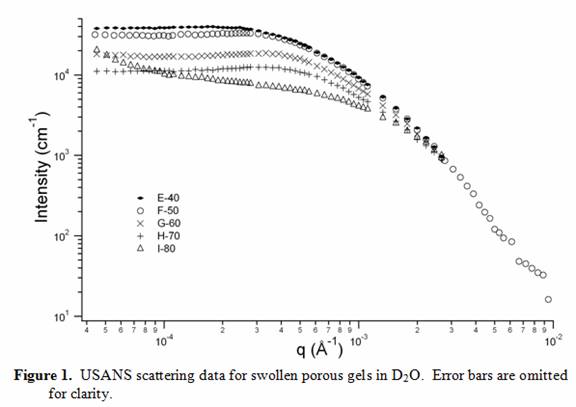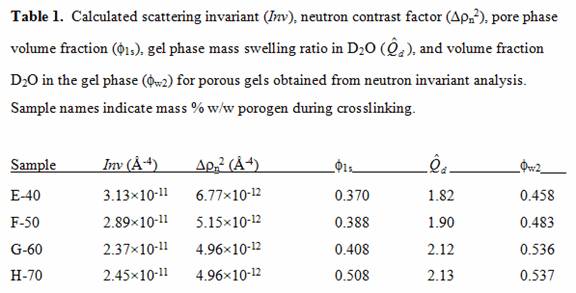www.acsprf.org
Reports: ND748944-ND7: Non-Affine Swelling and Swelling Kinetics of Microporous Polyelectrolyte Gels
Ronald C. Hedden, PhD , Texas Tech University
Optimizing the swelling kinetics, mechanical behavior, and stimuli-responsive properties of porous gels requires experimental methods for characterization of both pore volume fraction and gel-phase water content. Due to the possibility that the pore phase volume fraction may change during swelling, it is usually not possible to assume affine changes in the dimensions of the voids upon swelling/deswelling. A suitable theoretical framework relating pore volume fraction to the equilibrium volume swelling ratio was lacking prior to our work. Experimental methods were developed for the first time to calculate water concentration within the gel phase and the volume fraction of porosity in the swollen state. In addition, two novel techniques for creating (solvent-free) elastomers with micrometer-scale porosity were developed in the course of the work.
Our grant produced new knowledge regarding the swelling behavior of porous, sponge-like polymer hydrogels made of the slightly hydrophilic polymer poly(hydroxyethylmethacrylate), or poly(HEMA). We prepared and characterized poly(HEMA) gels that contain a high volume fraction (0.3 to 0.5) of micrometer-scale pores when swollen with water. Gels were crosslinked in the presence of 40 to 80 % w/w of an extractable, polymeric porogen, which microphase-separates from the poly(HEMA) during crosslinking. After removal of the porogen by soaking in water, the porous gels appeared strongly opaque due to the numerous pores, but they became transparent upon drying due to shrinkage or disappearance of the pore phase. These interesting materials served as models for our work on characterization techniques for determining pore volume fraction and water content in porous gels.
Ultra small-angle neutron scattering (USANS) and equilibrium swelling measurements were combined to characterize correlation length, pore volume fraction, and gel-phase water content in the porous poly(HEMA) gels. USANS experiments were conducted at the NIST Center for Neutron Research using the BT5 Perfect Crystal Diffractometer.1 Fig. 1 shows USANS data for a series of water-swollen gels that had different mass fractions of porogen (mass % porogen indicated by sample name). The porogen had already been extracted in each case, and water was replaced by D2O to increase neutron contrast. The USANS technique differs from ordinary SANS in that it can probe scattering from structures as large as several tens of micrometers, due to the extremely low q values accessible.
An analytical model was developed which relates the scattering invariant to chemical composition, swelling behavior, and structural parameters. The correlation length associated with porosity was measured by fitting USANS data to an appropriate scattering model, such as the Teubner-Strey model. By combining swelling measurements with USANS invariant analysis, it was possible to determine the equilibrium volume fraction of pores and the concentration of water in the gel phase (Table 1). These important parameters are not accessible to imaging techniques commonly used in materials characterization, such as electron microscopy. USANS measurements also confirmed that the pore phase essentially disappeared after slow drying of the gels in air. The USANS technique is a versatile, non-invasive method to characterize pore size, volume fraction, and water content in soft materials.
A novel technique for preparation of elastomers and gels with well-defined, interconnected pores was also developed in the course of our project. Polymer microfibers (e.g. polystyrene) were produced by electrospinning, and a polymer network was formed by crosslinking an incompatible liquid polymer (e.g. PDMS) around the microfibers. The new technique is useful for preparing pores of well-defined diameter, which can have preferred orientation.
The new USANS methods represent a useful advance in soft materials characterization, as the analytical methods we developed can be applied to characterize swelling behavior of many types of porous soft materials, including biological materials and superabsorbent synthetic polymers. In addition, we have gained new insights regarding the swelling of porous polymer gels, namely, that the pore size and volume fraction can be expected to vary strongly with the degree of swelling. Future work using the novel porous gels created from electrospun fiber templates will address two additional questions regarding the swelling of porous hydrogels: how does solvent quality affect pore size and volume fraction, and how does mechanical compression affect pore size and volume fraction? Approaching these key questions with our newly developed analytical tools will provide new insights regarding the influence of porosity on equilibrium swelling and mechanical response of porous gels and elastomers.
This ND grant benefited the careers of the PI and several students and postdoctoral reseachers. The PI has now established a new direction to his career: engineering of microporous soft materials. The results of the project were instrumental as preliminary data for writing a grant to the U.S. National Science Foundation-CBET, which was funded in 2011. A postdoc. who worked on the project, Mr. Jun Zhao, has obtained a faculty position at the Beijing University of Science and Technology. An undergraduate researcher, Ms. Morgan Iannuzzi, was first author on our recent paper due to her productive research experience in our group. A graduate student, Ms. Lan Ma, is using the new porous gel materials developed in her Ph.D. research. Overall, the ND grant has had a very positive impact on the careers of all involved.
1We acknowledge the support of the National Institute of Standards and Technology, U.S. Department of Commerce, in providing the neutron research facilities used in this work. This work utilized facilities supported in part by the National Science Foundation under Agreement No. DMR-0454672.


